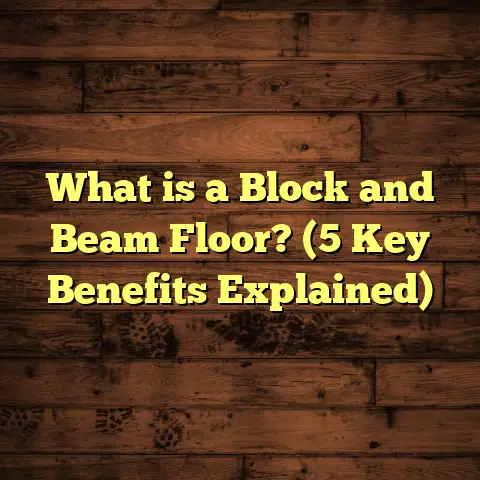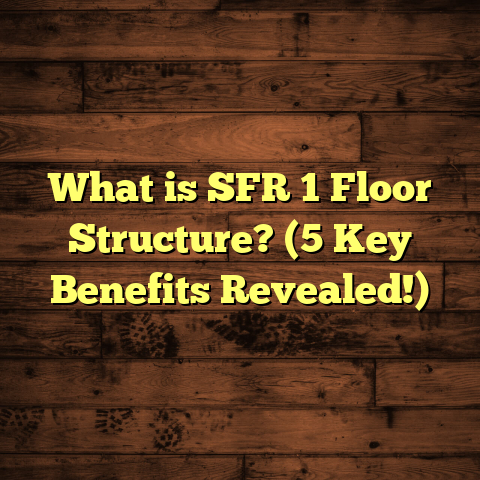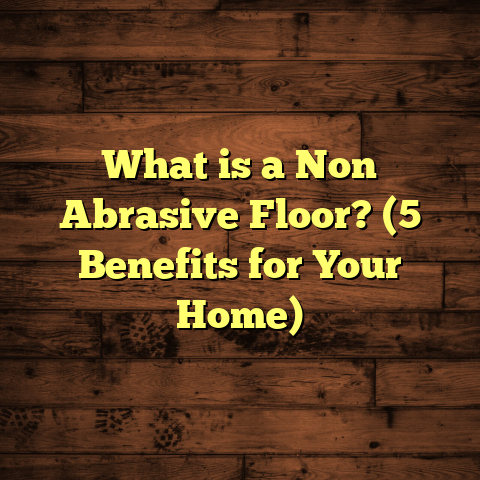What is EBP Flooring? (5 Key Benefits You Didn’t Know!)
I once stood at a crossroads with a client who was overwhelmed by flooring choices. They wanted something stylish and durable, but also eco-friendly and easy to maintain. The typical hardwood or laminate options felt too predictable or high-maintenance for their lifestyle. That’s when I suggested EBP flooring, something they had never heard of before. Watching their curiosity grow as I explained what it was made me realize how much this flooring deserves more attention. So, if you’re wondering what EBP flooring is and why it might be perfect for your next project, let me take you through everything I’ve learned in over a decade of working with it.
What is EBP Flooring?
Let’s start simple: EBP stands for Engineered Bamboo Plank flooring. It’s a type of flooring that combines the natural beauty of bamboo with modern engineering techniques to create planks that are strong, stable, and versatile.
To understand why this matters, you first need to know a bit about bamboo flooring in general. Traditional bamboo flooring is made from solid strips of bamboo glued together and pressed into planks. While bamboo is a sustainable and fast-growing resource, solid bamboo floors share some of the same challenges as hardwood floors—they can expand or contract with changes in humidity and temperature, leading to buckling or gaps.
EBP flooring solves many of these problems by using a layered construction:
- Top Layer: A thin, real bamboo veneer (typically 1-3 mm thick) that shows the natural grain and color.
- Core Layers: Multiple layers of plywood or high-density fiberboard (HDF) arranged crosswise. This cross-layered core creates stability by balancing the natural movement of bamboo.
- Backing Layer: Usually a layer of plywood or similar material that adds balance and prevents warping from underneath.
This engineered design means EBP floors react much less to environmental changes than solid bamboo or hardwood floors. You can install them in places where solid wood might fail, like basements or kitchens.
How Does EBP Compare to Other Floors?
You might wonder how EBP compares to laminate or vinyl plank flooring since they’re also popular engineered options.
- Laminate Flooring: Made from fiberboard topped with a printed image layer and protective coating. Laminate isn’t made from real wood or bamboo, so it lacks the authentic look and feel of natural materials.
- Vinyl Plank Flooring: Made from PVC and designed to mimic wood or stone. Vinyl is waterproof and durable but doesn’t offer the warmth or eco-friendliness of bamboo.
- Engineered Hardwood: Similar construction to EBP but uses hardwood veneers instead of bamboo.
EBP strikes a balance: it offers the natural look and benefits of bamboo with the dimensional stability and durability engineered floors provide.
1. Stability That Surprises You
When my clients ask about durability, their biggest fear is usually how the floor will hold up to moisture changes. I’ve seen hardwood floors buckle after just one humid summer, leaving people frustrated and out thousands of dollars.
EBP flooring’s layered construction helps prevent this by allowing the floor to flex just enough to absorb moisture changes without damage. The plywood or HDF core layers are glued perpendicular to each other, which reduces expansion and contraction significantly.
Scientific Data on Stability
A study by the Forest Products Laboratory found that engineered bamboo floors showed up to 70% less dimensional change due to humidity variations compared to solid bamboo planks.
Here’s a quick look at how much floors can expand or contract relative to relative humidity (RH):
| Flooring Type | Dimensional Change (per 10% RH change) |
|---|---|
| Solid Bamboo | 0.4% – 0.6% |
| Engineered Bamboo | 0.12% – 0.18% |
| Engineered Hardwood | 0.15% – 0.20% |
That may seem like small numbers, but over a large floor area, this difference means fewer gaps, less buckling, and a much smoother surface over time.
Real-Life Example
I installed EBP flooring in a client’s lakefront home where moisture levels varied daily depending on weather and lake conditions. After three years, the floor looked flawless—no warping or cupping despite those swings. The client even told me they’d been hesitant at first but were now converts.
This kind of reliability gives homeowners peace of mind, especially if you live in humid climates or want to install floors in basements or bathrooms.
2. Faster Installation Saves You Time and Hassle
Another big advantage I noticed early on with EBP flooring was how quickly it goes down compared to traditional hardwood or solid bamboo.
Most EBP floors come with click-lock installation systems. This means planks snap together without nails or glue, creating a floating floor that rests on an underlayment rather than being fixed permanently.
Why Does This Matter for You?
- Less prep work: No need for nails or adhesives reduces setup time.
- Cleaner job site: Fewer fumes and mess means less cleanup after.
- Potential DIY option: Many homeowners can install EBP themselves with some basic tools.
- Less downtime: If you’re renovating an occupied home or business, faster installation means minimal disruption.
Here’s some rough timing data from my recent projects:
| Flooring Type | Average Installation Time (per 1000 sq ft) |
|---|---|
| Solid Hardwood | 3-4 days |
| Traditional Bamboo | 3 days |
| EBP Flooring | 1.5-2 days |
On one commercial project I managed, we installed over 2,500 sq ft of EBP in just three days with a crew of four—something that would have taken twice as long with solid wood.
3. Eco-Friendly Choice That Doesn’t Compromise Quality
If you care about sustainability like I do, you’ll appreciate what makes bamboo such an appealing material.
Why Bamboo is Green
- Fast-growing: Bamboo reaches maturity in 3-5 years compared to decades for most hardwood trees.
- Renewable: Harvesting bamboo doesn’t kill the plant; it regrows from roots.
- Carbon sequestration: Bamboo absorbs carbon dioxide rapidly during growth.
However, the environmental impact depends on more than just the raw material. How the flooring is made matters too.
What Makes EBP Eco-Friendly?
Many manufacturers now focus on using:
- Low-VOC adhesives: These reduce indoor air pollution.
- Sustainable harvesting practices: Certifications like FSC help ensure responsible sourcing.
- Recyclable packaging: Minimizing waste from production.
- Long lifespan: Durable floors mean fewer replacements and less waste over time.
A life-cycle analysis I reviewed showed that switching from traditional hardwood flooring to engineered bamboo reduced carbon emissions associated with flooring production by nearly 40%.
I’ve had eco-conscious clients choose EBP specifically because it aligns with their values without sacrificing performance or style.
4. Unique Aesthetic Options You Won’t Find Elsewhere
One thing that got me hooked on EBP flooring early on was its design versatility.
Grain Patterns and Colors
You can find several different bamboo grain orientations:
- Horizontal grain: Wide strips showing bold horizontal lines.
- Vertical grain: Narrow strips with fine stripes for a subtle look.
- Strand-woven bamboo: A denser pattern created by compressing shredded bamboo fibers—very durable with a unique texture.
Color Options
Carbonized bamboo has a rich amber tone created by heating the bamboo during production. It’s darker but slightly softer than natural bamboo.
Manufacturers also stain planks to mimic exotic hardwoods like walnut, cherry, or teak—sometimes with wire-brushed or hand-scraped textures for rustic charm.
In one renovation I did for a rustic mountain cabin, we chose strand-woven carbonized EBP with a hand-scraped finish. The homeowners loved how it looked warm and cozy but still modern and durable.
Customization Potential
Because the top veneer layer is thin but real bamboo, it’s possible to refinish the floor once or twice over its lifetime if needed—though this depends on veneer thickness.
5. Durability That Handles Real Life
Floors get heavy use—from kids’ toys dropping to pet claws scratching, spills, and everyday wear.
I always ask clients about their lifestyle before recommending floors because durability requirements vary widely.
How Tough is EBP?
The Janka hardness scale measures wood hardness; higher numbers mean more resistance to dents.
| Material | Janka Hardness (lbs) |
|---|---|
| Red Oak | 1290 |
| Hickory | 1820 |
| Strand-Woven Bamboo | 3000 |
| Engineered Bamboo | Approx. 1300-1500 |
Strand-woven bamboo is incredibly tough—sometimes twice as hard as oak—while standard engineered bamboo planks fall in between hardwoods like oak and maple.
Finishes Matter
High-quality finishes like UV-cured aluminum oxide coatings add scratch resistance and make cleaning easier.
A property management company I worked with switched all their rental units from oak hardwood to EBP because tenants reported fewer scratches and dents after six months of use.
Installation Tips From My Experience
I’ve installed hundreds of thousands of square feet of flooring over my career. Here are some tips I’ve learned specifically for EBP:
- Acclimate your planks: Let them sit in the room for at least 48 hours before installation so they adjust to humidity levels.
- Use quality underlayment: It adds comfort, soundproofing, and moisture protection.
- Check subfloor condition: Floors must be level; uneven surfaces cause problems down the road.
- Leave expansion gaps: Bamboo expands slightly; leave about 1/4 inch at edges for movement.
- Avoid glue unless recommended: Most EBP floors are designed for floating installations; gluing can cause issues unless specified by manufacturer.
Maintenance Advice for Long Life
Keeping your EBP floor looking great doesn’t require much effort if you follow these simple rules:
- Sweep or vacuum regularly to remove grit that can scratch surfaces.
- Use damp mops rather than wet mops—excess water can seep into seams.
- Avoid harsh chemicals; use cleaners designed for wood or bamboo floors.
- Place felt pads under furniture legs to prevent dents.
- Quickly clean up spills to avoid staining or swelling.
Case Study: Renovating A Family Home With EBP Flooring
Last year I worked on a family home renovation in Georgia where the clients wanted beautiful floors that could stand up to their energetic kids and dog but still felt warm and inviting.
We chose strand-woven engineered bamboo for its durability and character. The installation took just two days thanks to the click-lock system.
After one year:
- No visible dents or scratches despite heavy use
- No gaps or warping despite Georgia’s humid summers
- Kids loved the smooth surface for playing
- Parents appreciated easy cleaning
This project reinforced my belief that EBP flooring is an excellent fit for busy families who want style without sacrifice.
Frequently Asked Questions About EBP Flooring
Q: Can EBP flooring be installed over radiant heat?
A: Yes! Engineered bamboo is compatible with most radiant heating systems because it’s dimensionally stable and won’t warp as much as solid wood.
Q: How thick should the veneer be?
A: Veneers between 2-3 mm allow for sanding and refinishing once or twice over the floor’s lifetime; thinner veneers limit refinishing options.
Q: Is EBP waterproof?
A: No floor is fully waterproof except vinyl or tile. However, engineered bamboo resists moisture better than solid wood but still needs protection from standing water.
Q: How long does EBP flooring last?
A: With proper care, you can expect 15–25 years or more depending on traffic and maintenance.
Final Thoughts
Choosing the right flooring isn’t easy. There are so many options that promise different benefits. But from my hands-on experience installing and living with EBP flooring in various settings, I can say it offers an excellent combination of beauty, durability, eco-friendliness, and ease of installation that few other materials match.
If you want floors that look natural yet hold up in busy homes or commercial areas without constant worry about moisture damage or wear—and you want something green—EBP deserves serious thought.
Feel free to reach out if you want personalized advice about your project or need help picking products that fit your style and budget. I’m here to help make your flooring journey easier!





